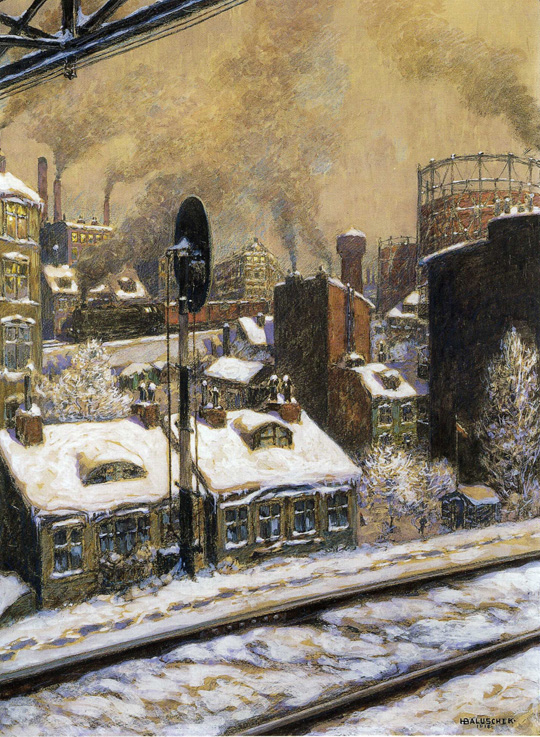I’m in Berlin and I’m in search of Hans Baluschek. On a street corner in Schöneberg on a warm July afternoon, passersby don’t have the answer. You haven’t heard of him? Too bad. Finally, I catch a glimpse in the Ceciliengarten estate, off Rubenstrasse. A plaque on the wall. It says: “Here lived, painted, drew and wrote: Hans Baluschek, 1929–1933.”

1933 was the year the Nazis seized power in Germany. In Berlin, they evicted Baluschek from the studio apartment given to him by the Social-Democratic city council four years earlier. Two years after his eviction, Baluschek died, his loss barely registered amidst the climate of fear that now prevailed. Thirty years earlier, Baluschek had been one of Berlin’s best known and most prolific artists. A founder member of the Berliner Secession, the city was his muse, just as it had been at one time or another for Adoph Menzel, Ernst Ludwig Kirchner and George Grosz.
Unfortunately for Baluschek, who had been a Social Democratic Party supporter for much of his life, the radicalisation of German politics in the 1920s led to his portraits of urban life being denigrated by fascists and communists alike. After the War, and after the partition of Berlin, neither the East nor the West were especially interested in recovering Baluschek’s legacy, so the artist was quickly, quietly forgotten.

Over twenty-five years after reunification, it’s still difficult to find traces of Baluschek in his home city. The Bröhan Museum, in Charlottenburg, occasionally shows some of his painted works (a retrospective was staged in 2012), while a telephone call will arrange an appointment to see his sketchbooks in the reading room above the galleries. There are also some of his works in the Stadtmuseum’s graphic collection behind the Ephraim Palais, and at the Akademie der Künste on Luisenstrasse. Some of his larger, more ambitious canvases are kept in storage at the Stadtmuseum’s depot, out in Spandau.
Out on the streets of the city, it’s even harder to find the elusive artist, despite them frequently being his chief subject matter. In Schöneberg, the giant gasometer that towers over the rooftops of the neighbourhood offers a tantalising glimpse, but doesn’t quite satisfy. In the north of the city, amongst the garden colonies of Wedding and Reinickendorf, you have the sense of being on the right track, while not being able to find precisely what you seek.

Fruitless searching reveals the truth: there is no definitive vision of Baluschek’s Berlin. “I am no photographer” the artist claimed. Instead, he constructed his drawings and paintings from a toolbox of ideal types, stowed away in the mind: a repository of tenement blocks, street lights, railway line signals and locomotives, of workers, prostitutes the unemployed masses, and children.
Therein lies the heart of the problem. Baluschek’s pictures were too stereotypical, too detached for the city’s communists, who preferred their art to be drawn directly from the brutal reality of everyday life. And yet at the same time they were too figurative, too florid for the supporters of modernism, who preferred their art to be more abstract, more detached.
Back at the Ceciliengarten estate, I take a photograph of the plaque mounted on the wall of Baluchek’s former home, which makes feel that I’m both an odd sort of pilgrim and an impostor. Never mind, I tell myself. At least here, if nowhere else in this city, I can content myself with knowing that I’ve finally tracked down the elusive and misunderstood Hans Baluschek.
Further Reading:
Hans Baluschek. “Im Kampf um meine Kunst” Die Gartenlaube 27 (1920), pp.447–50.
Margrit Bröhan. Hans Baluschek 1870–1935 : Maler – Zeichner – Illustrator. Berlin: Nicolai, 1985.